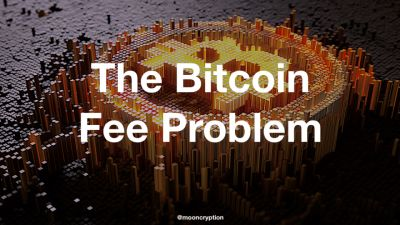Bitcoin (BTC) has been having fee issues for quite a while now. It's impossible to send bitcoins without attaching fees reaching exorbitant amounts, meaning that sometimes sending the bitcoin private key via postal mail is cheaper.
This is a huge problem and we need to address it soon, or risk tearing down all of the work Bitcoin has done over the past decade.

In this article, we'll address the Bitcoin fee issue and understand what's going on, in these different sections:
- The Problem - the cause and effect of the fee issue
- Solutions - possible solutions to the issue
Let's get started.
The Problem
Bitcoin operates on a blockchain, consisting of a digital ledger in which every transaction is recorded. However, it's inaccurate to imply that this ledger simply lists every transaction— a better analogy would be many ledgers, chained together— a blockchain.

When you broadcast a Bitcoin transaction, you transmit it to miners to be recorded onto the blockchain.
However, each block presently has a block size limit of 1 MB. This means that the number of transactions that can be recorded onto each block is limited.
Source of the Issue
When Satoshi Nakamoto was still involved in Bitcoin, he/she added a then-harmless line of code that limited the Bitcoin block size to 1 MB. At that time, this was huge— the blocks weren't even reaching close to that amount.
The reason for this addition was to deincentivize dust transactions, or very small transactions comparable to using a bank transfer to move two cents. Though his intentions were good, unfortunately it looks like this small line of code has started a massive debate within the Bitcoin community, and has led to a huge issue with Bitcoin blocks.
Simply put, Bitcoin blocks aren't infinite, and are capped by this limit. Miners can only choose a set number of transactions to place in each block. Why would they be incentivized to pick your transaction out of the thousands to millions of other ones? Fees.
Transaction Fees

Every transaction has a transaction fee paid by users to the miners. This transaction fee is paid out to the miner who places your transaction into their block.
Miners in general try to choose the transactions with the highest fee to be placed into a block, because this gives them the most profit. Thus, if you pay a higher fee, your transaction will get confirmed onto the blockchain much faster. However, if you pay a very low fee, your transaction may not get confirmed at all.
Cause and Effect
All of this wasn't a problem until very recently, as the largest BTC blocks never even approached the block size limit, and the minimum fee you needed to set to be confirmed quickly would be very low (just a few cents, or even less).
However, Bitcoin has become exponentially popular lately. This popularity is leading to much more transactions being output, and months ago, Bitcoin blocks started touching the block size limit. This means there wasn't enough space in blocks to hold all the transactions, so in order to get your transaction placed in a block quickly, you needed to pay a higher fee.
This cascading motion of blocks being too full and fees being too low ended in the situation we're at today. Fees are incredibly high right now, requiring insane amounts of money just to make a single transaction.
But is there a solution?
Solutions
Here, we'll go through an unbiased list of all the proposed and active solutions to this problem, and their pros and cons.
Segregated Witness (Segwit) -
Segwit is a protocol update that occurred a few months back, allowing some transactions to have a lower size than others.
However, it's opt-in, meaning you'll have to specifically adopt a Segwit wallet in order to take advantage of this.- Pros
- Lower Fees: Those who utilize Segwit wallets (such as Electrum and Ledger) can pay lower fees than others due to the lower transaction size.
- Ease the Burden: Because Segwit transactions have a lower size, by using Segwit, you help ease the burden on Bitcoin blocks and allow more transactions to be included into your block.
- Cons
- Slow Adoption: Exchanges, wallets, and users are being very slow to adopt Segwit, so it isn't providing as much of a boost as it can. Move to exchanges and wallets that support Segwit to experience the benefits, and help the Bitcoin blockchain.
- Pros
Lightning Network (LN) - The Lightning Network is a second-layer protocol that enables users to directly send transactions through payment channels. Once released, this will allow for virtually zero-fee transactions and instant confirmations.
- Pros
- Full Solution - The LN, once released, can fully solve the fee issue by greatly lowering fees and providing instant confirmations.
- No Hard Fork Required - The LN is a second layer solution, that works on top of the blockchain. It's also completely opt-in (but who doesn't want lower fees?).
- Cons
- Slow Development - The Lightning Network is not released yet, and development has been taking a really long time! We can't experience any of the benefits of this scaling solution if it doesn't release.
- Pros
On-chain Scaling - Some users believe that increasing the block size limit and allowing blocks to become bigger and bigger can solve the fee problem.
- Pros
- Fee Solution - Allowing blocks to become bigger means there's more space for transactions, meaning that fees can become lower.
- Easy Implementation - It's quite easy to implement this solution as it involves a very small change to a single line of code. In fact, it has already been implemented on several altcoins such as BCH.
- Cons
- Lack of Decentralization - If blocks become bigger and bigger, this may make it much harder for nodes and miners to operate on the network, as these nodes need to quickly download entire blocks in fast intervals. If the "bar" to become a node/miner gets raised such that you need to have a super-fast internet connection, this will lessen the number of nodes and miners and lead to unhealthy centralization.
- Hard Fork Required - This change can only be implemented in a hard fork, meaning nodes, miners, companies, and all Bitcoin users need to upgrade, or else this may lead to a contentious split in the community.
- Pros
The Bottom Line
Bitcoin currently requires exorbitant amounts of fees from users just to make transactions— not only does this make it impossible to use for the poor people of places like Venezuela and Africa, it also makes it very hard and expensive for regular users.
There are many proposed solutions on how to go ahead with this, and the cryptocurrency market crash today should be a stark reminder that we need to get to work, and get one of these solutions in place as soon as possible.
Thanks for reading,
— @mooncryption
The solution...use Steem.
Steem has zero fee transactions and three-second confirmations, but the problem is that it's not popular enough to be used for such transactions. Why?
My guess is that the account creation method is way too inefficient. Many people can't wait for days (to even weeks) just to get an account; on BTC or LTC, you can just create an address in seconds and you're good to go.
I think @steemit is going to try to fix this in the next hard fork (Steem protocol upgrade), titled "Velocity." Hopefully when this happens, more people will realize the potential in Steem.
I agree, the problem with DPOS blockchains is that you need someone else to create an account for you. Hopefully HF 20 will fix this (for STEEM at least).
HF 20 will likely make the account creation price completely free. This means that anyone can create an account creation service, from Steemit.com to Busy.org to Utopian.io or anyone else.
These account creation services will likely be free and instant as well. HF 20 will also change bandwidth limits and make it so that new accounts do not come with free SP (but can still vote and everything).
This way there's no incentive for spammers to spam up new accounts anyways, and the account creation services themselves can come up with ways to deter spam.
Lightning network sounds like it has potential. Hopefully that will start getting adopted. These fees are doing harm to BTC
Definitely! Hopefully things move quicker, as these fees make BTC very hard to use.
I think LN has to be the solution. Whichever currency crypto gets an instant and free transaction solution in place and widely implemented first will potentially clean up.
It's why I think Litecoin has risen so much. It already has segwit so if it can get LN adoption people may switch across from Bitcoin.
I agree! The only problem is that LN has been taking a long time to develop. Though there is a testnet version being tested right now, things are getting worse with the fee situation every day.
However, if the LN does come out, I would definitely support it as the best solution.
Awesome post, very informative. Thank you.
Thanks :)
Fees definitely need to come down it won't make sense long term as another coin just as good as bitcoin will come along cheaper. Thanks for this great outline @mooncryption
This is already starting to happen, actually, which is a huge problem for Bitcoin. We need to reduce fees or nobody will be able to use Bitcoin for actual transactions!
Thanks for your comment @bitdollar :)
For the time being, use BCH or LTC for faster and cheaper transaction purposes.
For transactions, have you heard of this coin called Steem? It has three second confirmations and zero fees! 😛
This post has received a 48.68% upvote from @lovejuice thanks to @mooncryption. They love you, so does Aggroed. Please be sure to vote for Witnesses at https://steemit.com/~witnesses.
Click meHello, you received a boost courtesy of @steemdunk! Steem Dunk is an automated curation platform that is easy and free for use by everyone. Need a boost?
Upvote this comment to support the bot and increase your future rewards!
friends this telegram pump group is very successful. I would recommend https://t.me/rocketpumptrader
Bitcoin was designed to be transaction-ally difficult to protect it's value. It was not designed to have low fees. Try Nano to avoid fees.
It hasn't been adopted yet because this is just the start!